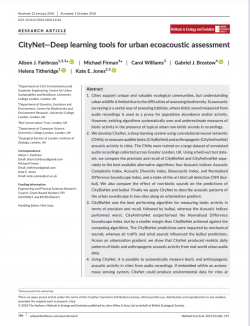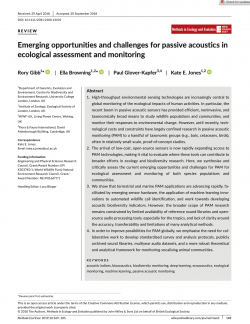CityNet—Deep learning tools for urban ecoacoustic assessment

Type
Journal
Category
Article
[ Browse Items ]
Publication Year
2018
Publisher
Methods In Ecology and Evolution, United Kingdom
URL
[ private ]
Tags
Abstract
1. Cities support unique and valuable ecological communities, but understanding urban wildlife is limited due to the difficulties of assessing biodiversity. Ecoacoustic surveying is a useful way of assessing habitats, where biotic sound measured from audio recordings is used as a proxy for population abundance and/or activity. However, existing algorithms systematically over and underestimate measures of biotic activity in the presence of typical urban non-biotic sounds in recordings.
2. We develop CityNet, a deep learning system using convolutional neural networks (CNNs), to measure audible biotic (CityBioNet) and anthropogenic (CityAnthroNet) acoustic activity in cities. The CNNs were trained on a large dataset of annotated audio recordings collected across Greater London, UK. Using a held-out test dataset, we compare the precision and recall of CityBioNet and CityAnthroNet separately to the best available alternative algorithms: four Acoustic Indices: Acoustic Complexity Index, Acoustic Diversity Index, Bioacoustic Index, and Normalised Difference Soundscape Index, and a state-of-the-art bird call detection CNN (bulbul). We also compare the effect of non-biotic sounds on the predictions of CityBioNet and bulbul. Finally we apply CityNet to describe acoustic patterns of the urban soundscape in two sites along an urbanisation gradient.
3. CityBioNet was the best performing algorithm for measuring biotic activity in terms of precision and recall, followed by bulbul, whereas the Acoustic Indices performed worst. CityAnthroNet outperformed the Normalised Difference Soundscape Index, but by a smaller margin than CityBioNet achieved against the competing algorithms. The CityBioNet predictions were impacted by mechanical sounds, whereas air traffic and wind sounds influenced the bulbul predictions. Across an urbanisation gradient, we show that CityNet produced realistic daily patterns of biotic and anthropogenic acoustic activity from real-world urban audio data.
4. Using CityNet, it is possible to automatically measure biotic and anthropogenic acoustic activity in cities from audio recordings. If embedded within an autonomous sensing system, CityNet could produce environmental data for cities at large scales and facilitate investigation of the impacts of anthropogenic activities on wildlife. The algorithms, code and pretrained models are made freely available in combination with two expert-annotated urban audio datasets to facilitate automated environmental surveillance in cities.
2. We develop CityNet, a deep learning system using convolutional neural networks (CNNs), to measure audible biotic (CityBioNet) and anthropogenic (CityAnthroNet) acoustic activity in cities. The CNNs were trained on a large dataset of annotated audio recordings collected across Greater London, UK. Using a held-out test dataset, we compare the precision and recall of CityBioNet and CityAnthroNet separately to the best available alternative algorithms: four Acoustic Indices: Acoustic Complexity Index, Acoustic Diversity Index, Bioacoustic Index, and Normalised Difference Soundscape Index, and a state-of-the-art bird call detection CNN (bulbul). We also compare the effect of non-biotic sounds on the predictions of CityBioNet and bulbul. Finally we apply CityNet to describe acoustic patterns of the urban soundscape in two sites along an urbanisation gradient.
3. CityBioNet was the best performing algorithm for measuring biotic activity in terms of precision and recall, followed by bulbul, whereas the Acoustic Indices performed worst. CityAnthroNet outperformed the Normalised Difference Soundscape Index, but by a smaller margin than CityBioNet achieved against the competing algorithms. The CityBioNet predictions were impacted by mechanical sounds, whereas air traffic and wind sounds influenced the bulbul predictions. Across an urbanisation gradient, we show that CityNet produced realistic daily patterns of biotic and anthropogenic acoustic activity from real-world urban audio data.
4. Using CityNet, it is possible to automatically measure biotic and anthropogenic acoustic activity in cities from audio recordings. If embedded within an autonomous sensing system, CityNet could produce environmental data for cities at large scales and facilitate investigation of the impacts of anthropogenic activities on wildlife. The algorithms, code and pretrained models are made freely available in combination with two expert-annotated urban audio datasets to facilitate automated environmental surveillance in cities.
Description
https://besjournals-onlinelibrary-wiley-com.proxy.library.adelaide.edu.au/doi/full/10.1111/2041-210X.13114
Number of Copies
1
| Library | Accession No | Call No | Copy No | Edition | Location | Availability |
|---|---|---|---|---|---|---|
| Main | 252 | 1 | Yes |

